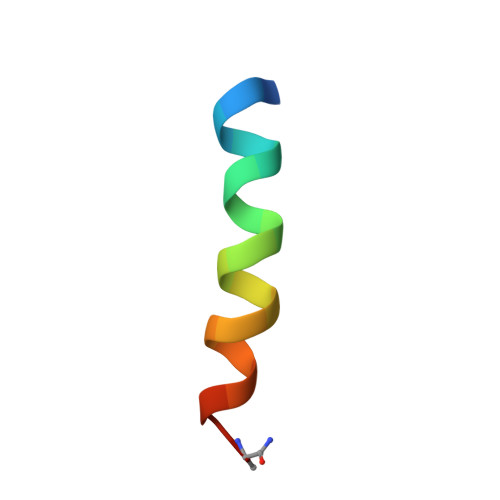NMR Structure of Calmodulin Complexed to an N-Terminally Acetylated alpha-Synuclein Peptide.
Gruschus, J.M., Yap, T.L., Pistolesi, S., Maltsev, A.S., Lee, J.C.(2013) Biochemistry 52: 3436-3445
- PubMed: 23607618
- DOI: https://doi.org/10.1021/bi400199p
- Primary Citation of Related Structures:
2M55 - PubMed Abstract:
Calmodulin (CaM) is a calcium binding protein that plays numerous roles in Ca-dependent cellular processes, including uptake and release of neurotransmitters in neurons. α-Synuclein (α-syn), one of the most abundant proteins in central nervous system neurons, helps maintain presynaptic vesicles containing neurotransmitters and moderates their Ca-dependent release into the synapse. Ca-Bound CaM interacts with α-syn most strongly at its N-terminus. The N-terminal region of α-syn is important for membrane binding; thus, CaM could modulate membrane association of α-syn in a Ca-dependent manner. In contrast, Ca-free CaM has negligible interaction. The interaction with CaM leads to significant signal broadening in both CaM and α-syn NMR spectra, most likely due to conformational exchange. The broadening is much reduced when binding a peptide consisting of the first 19 residues of α-syn. In neurons, most α-syn is acetylated at the N-terminus, and acetylation leads to a 10-fold increase in binding strength for the α-syn peptide (KD = 35 ± 10 μM). The N-terminally acetylated peptide adopts a helical structure at the N-terminus with the acetyl group contacting the N-terminal domain of CaM and with less ordered helical structure toward the C-terminus of the peptide contacting the CaM C-terminal domain. Comparison with known structures shows that the CaM/α-syn complex most closely resembles Ca-bound CaM in a complex with an IQ motif peptide. However, a search comparing the α-syn peptide sequence with known CaM targets, including IQ motifs, found no homologies; thus, the N-terminal α-syn CaM binding site appears to be a novel CaM target sequence.
Organizational Affiliation:
Laboratory of Molecular Biophysics, Biochemistry and Biophysics Center, National Heart, Lung, and Blood Institute, National Institutes of Health , Bethesda, Maryland 20892, United States.
















